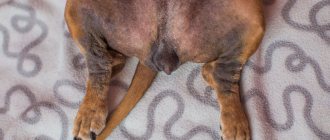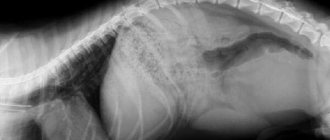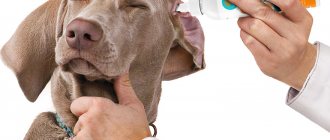Alena Igorevna Goncharenko
veterinarian Petstory
Skin diseases in dogs are one of the most common reasons to visit a veterinarian. According to statistics, these problems account for at least 30% of all types of visits to clinics. Many “sores” on the skin of dogs visually look very similar to each other, but the reasons that cause them are extremely diverse and require a completely different approach, treatment and have different prognoses.
- Superficial pyoderma
- Demodicosis
- Dermatophytosis
- Allergy
Let's look at the main skin diseases in dogs with descriptions and photos of the diseases.
The structure of a dog's skin
The skin is the largest organ of a pet, weighing from 12 to 25% of the animal’s body weight, which depends on its size and nutrition. Its task is to protect internal organs from damage that may occur from the external environment. It also regulates body temperature and is responsible for the sense of touch.
The skin of an animal consists of epidermis, dermis, and subcutaneous fat. It also includes skin appendages – fur and claws.
Epidermis
The epidermis is a tough outer layer consisting of several types of cells, each of which has its own functions.
Keratocytes
Keratocytes are the topmost layer responsible for the protective function. It consists of keratinized scales. They originate in the lower layers of the epidermis, multiply, lose their nucleus and are destroyed as they move upward. Thus, keratocytes create a dense layer of dead cells on the surface. They are able to retain fluids, salts and other nutrients within the body without allowing harmful agents to pass through.
The top layer of dead cells is constantly shed and replaced by new keratocytes. The speed of regeneration depends on nutrition, hormones, genetics, and the pet’s immunity. Chronic diseases, internal and external inflammation, and some medications also affect cell growth and skin renewal.
Melanocytes
Melanocytes are adjacent to the epidermis, hair follicles, ducts of the sebaceous and sweat glands. They are responsible for the coloring of the pet's skin and fur. Their synthesis is controlled by hormones and genes received from parents. Melanin helps protect the body from harmful ultraviolet rays.
Langerhans cells
Langerhans cells are part of the immune system. They participate in:
- skin reactions that occur in response to foreign agents;
- promote the appearance of rashes when the epidermis comes into contact with irritating substances.
Langerhans cells are damaged by exposure to ultraviolet light and certain medications.
Merkel cells
Merkel cells are responsible for the sense of touch. They help pets receive sensory information from their whiskers and paw pads. When stretched, the cells stimulate the release of the hormone serotonin into the blood, which causes smooth muscle contraction.
basement membrane
The basement membrane separates the epidermis from the dermis, the next layer of skin. It accelerates cell regeneration processes, their metabolism, and improves skin elasticity. Autoimmune diseases, as well as skin diseases that penetrate deeply, can disrupt its functions.
Dermis
Blood vessels pass through the dermis, so it is responsible for nourishing the epidermis, fur, and claws. Veins and arteries, contracting and expanding, regulate the animal’s body temperature. There are also motor and sensory nerves, the fibers of which reach the hair follicles. Therefore, the dog reacts sensitively to cold, warmth, pain, and touch.
The dermis synthesizes the protein collagen, which maintains the integrity of the skin and affects its elasticity. As in the epidermis, there are immune cells that stop the infection that could penetrate through the top layer.
Subcutaneous fat
Subcutaneous fat is the deepest layer, consisting of loose connective and adipose tissue. Here are the hair follicles, lymphatic and blood vessels, and nerves. Adipose tissue is a depot of stored glucose, from which the body takes energy. It participates in homeostasis, protecting the pet’s body from heat loss, reducing the force of impact during mechanical damage.
Wool
Wool protects the skin from injury and helps regulate body temperature. It not only warms, but also cools the skin, so it is not recommended to shave the animal in the summer.
Hair follicles are located deep in the skin. From each comes a central hair, which is surrounded by small hairs - more in winter, less in summer. Hair growth is affected by nutrition, hormones, and time of year. Molting occurs before a radical change in season, and may even begin in the middle of winter or summer. Dogs also lose their fur when the temperature changes or when exposed to the sun.
The sebaceous glands, which are adjacent to the surface of the skin, secrete a secretion that keeps the skin moist and elastic. It adds shine to the coat, making it healthy (if sebum production does not exceed the norm).
Claws and pads
The foot has pads, which are the toughest part of the skin. They perform several functions:
- the pet sweats through the pads, which helps regulate body temperature;
- provide traction and shock absorption;
- absorb shocks, increasing endurance.
Scent glands are attached to the pads, leaving a scent that other animals can smell.
The dog's nails are strong and hard. They help the pet to run, maneuver, dig, defend itself, and ensure leg stability.
Juvenile cellulite
Juvenile cellulitis is a disease of unknown etiology, characterized by inflammation of the subcutaneous tissue in puppies. The disease is rare. Mostly puppies are affected from 3 weeks of age to 4 months.
Symptoms:
- Swelling of the muzzle, usually painful.
- Swelling of the genitals, anus area.
— Subsequently, the hair around the eyes and on the chest begins to fall out.
— The mandibular lymph nodes become inflamed.
Most often, the puppy's eyelids, bridge of the nose, eyelids, chin, lips, and ear canal are affected. Sometimes other parts of the body are affected, the torso most often. The rash is painful, but the itching is not severe. The consequences of the disease are inflammation of the lymph nodes, purulent arthritis, and loss of appetite.
Treatment:
1. The disease is treated with drugs that are in the group of corticosteroids; doses are calculated individually and depend on the weight of the puppy. Prednisolone is the most commonly prescribed substance and is used orally for treatment.
2. Locally affected skin is not treated, since animals actively resist this process. If infected a second time, antibacterial treatment is carried out.
============================================================================================================================================================================================
Causes of skin diseases
Animal skin diseases in veterinary medicine (dermatitis) are one of the most common pathologies. This is due to the fact that problems with the animal’s fur and skin are easy to notice with the naked eye.
The reason may be various factors:
- poor nutrition;
- stress;
- adverse reactions to medications;
- allergies to food, chemicals;
- a bowl made of low-quality, toxic plastic;
- worms, fleas, ticks;
- contact with a sick animal;
- fungi;
- skin trauma, especially wounds accompanied by inflammation;
- chronic diseases of internal organs.
Symptoms that should alert you
Each disease has its own special symptoms. Despite this, some symptoms often overlap. The most common ones include the following:
- itching;
- swelling and redness;
- fragility and hair loss;
- dandruff;
- wounds and ulcers.
A sick pet loses appetite, activity and falls into apathy. Having noticed such changes, it is necessary to carefully study all the accompanying signs. Thanks to them, you will be able to make a preliminary diagnosis and take the necessary safety measures.
Main types of skin diseases in dogs
Skin diseases in dogs can occur quickly (irritation appears, heals, disappears) or in a chronic form, which requires lifelong treatment. Some pathologies can be inherited - seborrheic dermatitis, follicular dysplasia, alopecia.
Skin diseases are primary and secondary. In the first case, the disease affects the animal’s skin (demodex, eczema). In the second, the cause of itching, scratching, and excessive shedding are internal pathologies (allergies, autoimmune diseases, problems with the digestive system).
Cushing's syndrome
LOCATIONS
Cushing's syndrome in dogs or hyperadrenocorticism is one of the most common diseases of the endocrine system in dogs, which occurs when excessive production of the hormone cortisol by the adrenal glands (located in the abdominal cavity) or adrenocorticotropic hormone by the pituitary gland (located in the brain).
Symptoms:
- Increased thirst and urination.
- Increased appetite.
- Obesity.
- Skin changes may be characteristic (alopecia without signs of itching, thinning and inelasticity of the skin, comedones).
— Muscle weakness/wasting, sagging abdomen (“pot-bellied” appearance).
— Disturbance of the reproductive cycle in females and atrophy of the testes in males.
- Noisy and rapid breathing.
— Neurological signs.
Treatment:
1. Drug treatment in the form of tablets (ketoconazole, mitotane, etc.).
2. Surgery (for unilateral adrenal tumor).
===========================================================================================================================================================================================
Immune problems (allergies, atopic dermatitis)
Skin diseases can be a consequence of poor or increased functioning of the immune system. If the immune response is insufficient, skin diseases in animals are considered secondary. An example is increased susceptibility to demodicosis (Demodex mites, which live on the skin of almost all dogs, but the pathology affects only a few).
Increased, but dangerous for the skin, immune reactions can be divided into 2 types - atopic dermatitis and autoimmune diseases.
Atopic dermatitis (allergy)
Atopic dermatitis is an increased reaction to an irritant that would not normally cause problems. It is usually a hereditary, incurable allergic disease that begins after 6 months of age, earlier in some breeds, including the Golden Retriever.
The most common symptoms of canine skin disease are itching, discharge from the eyes, and hives (red spots on the skin). In severe cases, scabies affects the entire body, swelling appears, and anaphylactic shock is possible.
Allergies can be triggered by various factors:
- Food;
- pollen of trees, grasses, weeds;
- mold;
- dust mites.
The result of atopic dermatitis can be infectious lesions of the ears and skin, provoked by various bacteria and fungi.
The diagnosis is made by eliminating the causes that can cause irritation, incl. fleas, ticks, and other parasites. A blood test for allergens can also help determine the source.
How to treat atopic dermatitis in dogs?
Treatment involves the mandatory exclusion of the allergen from the animal’s life. Stop-Itching suspension will help remove scabies. You should also pay attention to strengthening the immune system (Immunofan) and the liver (Hepatovet), which removes poisons from the body.
Autoimmune diseases
Autoimmune pathologies develop when immune cells begin to kill healthy tissues of the body.
Pemphigus foliaceus is one of the most common autoimmune diseases in four-legged pets. Description of skin disease in dogs:
- The skin becomes covered with blisters filled with pus, which quickly burst, forming crusts and erosions.
- First, the muzzle, ears, paws, and bridge of the nose are affected, but sometimes the skin disease of animals can cover the entire body.
- When the paw pads are affected, hyperkaratosis develops.
Other common autoimmune diseases that cause blisters include:
- bullous pemphigoid – occurs more often in older pets;
- epidermolysis bullosa - pathology can affect the dermis.
What to do?
To treat dermatitis in a dog, the doctor prescribes medications that normalize the functioning of the immune system and also reduce its response. Immunosuppressants and steroids help relieve symptoms.
Demodicosis
LOCATIONS
Demodicosis in dogs is a parasitic disease. Caused by microscopic mites of the genus Demodex, which feed on skin and loose fiber.
Symptoms:
— At the beginning of the disease, severe itching appears, the dog itches for several hours in a row. Then redness at the base of the hair becomes visible. After a few days, bubbles appear at the site of redness with contents that are first brick-colored and then clay-colored. Within 3 - 4 days, hair falls out at the site of the lesion, the bubbles burst, releasing the foul-smelling contents. This is how the pustular or pustular form of demodicosis manifests itself. If there are less than five spots of hair loss, they speak of a local lesion. If 5 or more spots are visible on the dog’s body, a generalized form is diagnosed.
— Dry scales are often found on the body, sticking the fur together. The scales may resemble sun-bleached dirt, bran, or fish scales. After a few days, the scales fall off along with the dog's fur. Pus is visible underneath them.
— In severe cases, the dog is depressed and refuses food. Body temperature can drop to 37 degrees.
Demodicosis can last for years. Without qualified help, dogs die from exhaustion or blood poisoning.
Treatment:
1. Macrolytic lactones, which include avermectins and milbemycins. Avermectins should only be given orally (with food, drink), these include Novomek, Baymek, Ivermag (actually ivermectins) and Dectomax (it is related to doramectins). What about milbemycins? Milbemax, an interceptor, for example.
2. To destroy adult ticks that find themselves near blood vessels, use ivermectin or doramectin preparations. Ivermectin is deadly to Collie and Sheltie dogs; these animals are administered only doramectin under the supervision of an experienced veterinarian.
To destroy the causative agent of demodicosis in dogs, use yam or aversectin ointment.
3. The use of formamidines (amit, bipin, certificate, amitan) is also necessary. Do not forget about drugs related to fluralaners and afoxolaners (the best “representatives” are Bravecto and Nexgard).
4. There is also a “subgroup” - moxidectins (it includes drugs such as “Advocate” and “Cydectin”).
5. To restore the integrity of the skin, wound healing and antiseptic drugs are used.
============================================================================================================================================================================================
Infectious skin diseases
The group of infectious diseases includes parasitic, fungal, viral, and bacterial infections.
Parasitic diseases
The most common parasitic skin disease in dogs and cats is fleas. They settle on the animal's body and cause itching, which causes the pet to scratch furiously and chew itself. Dogs often develop an allergic reaction to the secretion secreted by fleas during bites. It increases itching, causes redness of the skin, scabs, and purulent bumps.
The only way out in this situation is to treat your dog for fleas in a timely manner. Drops, sprays, tablets, and collars help cope with the task.
Parasitic infections include ticks. The most common are scabies and demodicosis, which cause itching and baldness. Previously, in veterinary medicine, these skin diseases of dogs were considered incurable. Now tablets are prescribed for treatment - Nesgard, Simparica, etc. With regular use, the number of mites returns to normal levels.
Fungal skin diseases in dogs
The most dangerous fungal infection is ringworm, caused by a dermatophyte. Bald patches covered with scales appear on the face, ears, tail, and paws. They are surrounded by dull fur with broken hairs. Some dogs develop itchy bumps that can develop into large bumps with ulcers.
The dog can also be affected by:
- Malassezia dermatitis, the fungus that causes it, is safe and lives on pets for life. Activated when the immune system is weakened, against the background of flea dermatitis, demodicosis.
- Candidiasis - develops when the candida fungus is activated, which is part of the microflora and normally does not harm. Symptom – ulcers on the mucous membranes, the appearance of gray-white plaques.
- Onychomycosis is a nail fungus that causes nails to crumble and fall out.
What to do?
Fungal skin diseases of dogs require immediate diagnosis and treatment. To protect your dog from ringworm and other fungi, vaccinate him with Vakderm. This medicine, as well as Fungin forte spray, can be used to treat the disease. An ointment that has antiseptic, astringent properties and stimulates cell regeneration helps a lot.
Bacterial infections
The most typical form is purulent inflammation, when bacteria penetrated an open wound and caused rotting. In this case, salicylo-zinc ointment will help, which kills the infection and accelerates cell healing.
Another pathology that a dog may encounter is Alaban rot, caused by E. coli toxins. Manifested by redness, erosions, ulcers, fever, anorexia, vomiting. The pathology is dangerous because it can cause kidney damage and death of the pet. Treatment is symptomatic; blood transfusions may help.
Mite infestation
Symptoms:
— Often the animal is worried about the attached tick: it itches, shakes its head if the tick has got into the ear.
— Rapid rise in body temperature to 41-42°C. This is the dog’s body’s response to the introduction of the parasite.
— At the site of the bite, two to three hours after removing the parasite, pronounced local redness is observed.
- Swelling, increasing in radius from the center of the bite, increased skin temperature in this area, redness, itching and pain.
— The animal licks and scratches the bite sites.
— Animals refuse to eat, show drowsiness and apathy.
— If a lump appears at the site of the bite, this may be the result of an allergy to the saliva of the parasite or infection of the wound or the tick head remaining in the wound. Hair may fall out at the site of the bump, and the dog reacts painfully to touching it. Purulent inflammation at the site of the bite appears due to the introduction of pyogenic microbes into the open wound.
— Some of the listed symptoms may appear: trembling, thirst, shortness of breath, pale mucous membranes, abdominal pain, foul odor from the mouth, blood in the urine, vaginal bleeding (in bitches), impaired motor reflexes: unsteadiness of gait, paralysis of the hind limbs (“tick-borne”) paralysis"), dysphonia (the dog cannot bark), dysphagia (lack of swallowing), sometimes vomiting and diarrhea and some others.
Treatment:
1. Remove the tick.
2. Disinfect the wound.
3. Use of antiparasitic drugs after consultation with a veterinarian.
Prevention:
- Anti-tick drops.
— Antiparasitic collar.
— Protective overalls.
============================================================================================================================================================================================
Seborrheic dermatitis
When the sebaceous glands work normally, the coat glows with health and beauty. If the production of sebaceous secretions is disrupted, seborrhea develops. Skin diseases in animals come in 2 forms:
- Dry – the sebaceous glands produce little secretion, which leads to excessive flaking, dandruff, and hair loss. The main causes of seborrhea in dogs are poor nutrition, stress, and mites.
- Oily – develops due to increased activity of the sebaceous glands. Symptoms of oily seborrhea in dogs - the hair sticks together at the base, oily plaques appear. The main reason is hormonal imbalances, poor diet, and mites.
What to do?
If you notice symptoms of seborrhea in dogs, contact your veterinarian for treatment. If your dog has hormonal imbalances, you need to get tested and adhere to the prescribed therapy.
A properly selected diet will improve your pet's health. In the treatment of seborrhea in dogs, medications that improve the condition of the skin and coat will help:
- Essential 6 spot-on (LDCA). It contains oils that need to be rubbed into the skin. They soothe and moisturize irritated epidermis.
- Complex supplements that contain B vitamins, Omega-3 acids and other beneficial substances that improve the condition of the skin and coat (8in1 Excel Brewers Yeast).
Briefly about the main thing
- There are a lot of diseases that cause pathological processes on the skin and they can only be distinguished from each other through laboratory tests.
- If you notice any deviation in your dog’s condition, this is a reason to contact a specialist, because if you hesitate, further treatment will take much longer.
- Be sure to examine your pet for any abnormalities.
- Approach your dog's nutrition with great responsibility.
Treatment of skin diseases in dogs
The treatment regimen should be prescribed by the doctor after determining what skin disease the dog has. In addition to treating the underlying disease, it is recommended to focus efforts on improving the functioning of the immune system and the liver, which is responsible for processing toxins.
The following drugs will help in the treatment of demodicosis:
- Imunofan (NPP Bionox) in ampoules. A hormonal agent that normalizes the immune system, restoring the acid-base balance.
- Hepatovet Active (Api-San) for dogs. The drug strengthens the liver, binds toxins, improves metabolism.
Preventive actions
The best way to combat skin pathologies is their prevention. To protect your four-legged friend, you need to take care of antiparasitic treatment and strengthen his immunity.
Planned treatment against ectoparasites
The treatment schedule for ectoparasites depends on the chosen product. Drops and sprays last the longest. It is enough to apply them only once a month.
It is better to spray sprays daily. They evaporate quite quickly and do not always reach the epidermis through too thick coat.
Maximum activity of ticks and other parasites is recorded from April to October. At this time, it is recommended to add collars to the listed drugs. In the absence of allergies, they are worn on a regular basis.
Prevention and dietary recommendations
Keep an eye on your dog and avoid contact with sick animals. Eliminate allergens if a rash appears on your stomach. Treat your dog regularly for fleas and ticks. To avoid ringworm, scabies and other fungal skin infections, get vaccinated. Strengthen your dog's immunity.
Many skin diseases in dogs are caused by poor nutrition, so pay special attention to the diet. Consider these factors:
- Do not give food from the table, especially peppered, fried, fatty foods.
- If you prefer artificial food, buy only a high-quality product.
- During feeding, monitor your pet's reaction. Discharge from the eyes and hives are a reason to reconsider your diet.
- Add omega-3 fatty acids to your food. They reduce skin inflammation in chronic skin diseases in dogs.
During treatment, do not forget to give your dog vitamins and minerals that affect skin health:
- Vitamin A – deficiency leads to peeling.
- Vitamin E, selenium - neutralize the effect of free radicals, prevents the destruction of connective tissue.
- B2 – deficiency causes cracks.
- B7 – deficiency leads to baldness.
- Zinc – is involved in the synthesis of collagen, which helps maintain skin elasticity. It also prevents drying and peeling of the skin.
- Copper deficiency causes incomplete keratinization, which leads to excessive dryness.
What can the owner do?
- Adjust the dog's diet
. The development of dermatitis is promoted by deficiencies of vitamins A, B and unsaturated fatty acids. To compensate for their lack in feed, the veterinarian may prescribe vitamin-mineral complexes and other feed additives. For dogs suffering from skin diseases, the AVZ company offers the mineral and vitamin feed additive “Bone with Brewer’s Yeast.” - Follow proper care for your pet.
First, you need to avoid rubbing the skin with the collar and muzzle, if any. In addition, skin dermatitis tends to be complicated by a bacterial infection, so the affected areas can be treated with antiseptics, but only as prescribed by a doctor. For these purposes, the AVZ company offers a solution “Migstim” based on the antimicrobial drug miramistin, supplemented with chamomile extract, which has an anti-inflammatory effect, chitosan succinate and ethyl alcohol. - Follow treatment tactics.
External agents in the form of ointments, gels and sprays should be applied as prescribed by the doctor, do not interrupt the course and do not skip treatments. For complications of dermatitis with a microbial infection, the veterinarian may prescribe oral antibacterial drugs, and for fungal infections, antifungal drugs. These medications may have side effects such as nausea and decreased appetite. But the treatment must be continued, just consult a doctor to adjust the prescriptions. As a rule, the inclusion of antioxidants and hepatoprotectors in the course can reduce unpleasant symptoms.
To prevent skin diseases of bacterial etiology, Okvet medicinal zoo shampoo with chlorhexide can be prescribed.
Hair loss during shedding
Dog hair lasts a certain period of time, after which it falls out, and a new one grows in its place. In most cases, this is a natural process, even if the fur comes out in clumps. Depending on the type of keeping and other external factors, dogs have several types of shedding:
- seasonal;
- age;
- continuous;
- pathological
The first moult in puppies results in the replacement of soft juvenile hair with coarser adult hair. Then twice a year dogs experience seasonal shedding. Under the influence of external stimuli (lighting, temperature), endocrine regulation is triggered, triggering the growth of the undercoat and longer guard hair. A similar procedure occurs in the spring, when downy hair begins to fall out. Seasonal molting lasts for several weeks (up to 1.5-2 months) and begins from the head, gradually moving along the back to the tail and limbs.
In animals kept in warm apartments throughout the year, seasonal molting is not pronounced. Instead, hair falls out as the follicles age and die. This coat change is not noticeable, but can intensify under various external influences. In this case, pathological molting develops, which is associated with parasitic, infectious and other diseases.
Diagnostics in a veterinary clinic
Diagnosis of skin diseases is associated with certain difficulties, since pathologies have many similar signs. To make an accurate diagnosis, the veterinarian needs to conduct a visual examination of the animal, collect anamnesis and perform a number of necessary diagnostic tests.
If allergic dermatitis is suspected, the doctor interviews the owner to identify the etiology of the allergen. In particular, he is interested in the symptoms of the disease, the frequency of relapses, information about the parents, feeding and maintenance features, walking, previous illnesses, etc.
The diagnostic approach depends on a detailed medical history in conjunction with physical and dermatological examination. Mandatory diagnostic methods include:
- blood tests (general, biochemical);
- stool and urine analysis;
- skin scraping;
- trichogramma;
- cytology;
- mycological studies;
- PCR diagnostics of pathogens.
The presence of lichen is determined by using a UV lamp. If cancer is suspected, a skin biopsy is performed.
Folliculitis
Superficial bacterial folliculitis is an infection that causes sores, bumps, and scabs on the skin. These skin abnormalities are easier to see in short-haired dogs.
In long-haired dogs, the most obvious symptoms may be a dull coat and flaky skin underneath. Folliculitis often occurs in combination with other skin problems such as scabies, allergies, or trauma.
Treatment may include oral antibiotics and antibacterial ointments or shampoos.
Symptoms of the lesion
Regardless of what caused the disease, all symptoms have common features:
- Changes in the color and condition of the skin, hyperemia, swelling, inflammation, peeling, formation of crusts, leakage of ichor when cracking or scratching the surface, purulent discharge when a bacterial infection occurs.
- Thinning, thinning or complete loss of fur.
- Severe itching and pain. The dog constantly scratches the sore spot, may even try to bite, does not allow anyone to approach him, examine or treat the damage, becomes aggressive or apathetic, lethargic.
- With large affected areas, the animal becomes especially susceptible to other diseases.
Don't expect everything to go away on its own. The disease will progress.
Risk group
The risk group for the development of dermatological diseases includes:
- puppies up to six months of age;
- elderly pets;
- animals with weakened immune systems;
- pets who have undergone surgery or acute infectious diseases;
- dogs undergoing serious drug treatment;
- animals receiving poor quality nutrition;
- pets in contact with untested or stray animals;
- animals living in unsanitary conditions.
Scabies
Scabies is a skin disease caused by tiny parasites called mites. Sarcoptic mange, also known as canine mange, spreads easily among dogs and can also be transmitted to humans, but the parasites do not survive on humans.
Symptoms include severe itching, redness of the skin, ulcers and hair loss. The dog's ears, face and legs are most often affected. Demodectic mange can cause bald spots, scabs and sores, but is not transmitted between animals or people. Treatment depends on the type of scabies.
Yeast infections
If your dog can't stop scratching his ear, licking or chewing his toes, ask your veterinarian to check for a yeast infection. Symptoms include irritation, itching, or skin discoloration.
The infection usually affects the paws or ears, where yeast has room to grow. Yeast infections are easy to diagnose and often respond well to topical creams.
In some cases, your veterinarian may prescribe oral medications, medicated sprays, or medicated baths.











